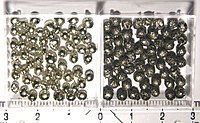
Photo from wikipedia
Abstract Different with Wang et. al.’s study, we found that polymeric Si–O–Sn 2+ rather than Ni-Sn alloy and metallic Sn are active species in silica-supported tin oxide catalysts for dehydrogenation… Click to show full abstract
Abstract Different with Wang et. al.’s study, we found that polymeric Si–O–Sn 2+ rather than Ni-Sn alloy and metallic Sn are active species in silica-supported tin oxide catalysts for dehydrogenation of propane. The results showed that high surface area of mesoporous silica brought about high dispersion of tin oxide species, as a result, catalytic activity and stability were both improved. DRUV–vis, XPS, TPR and XRD studies of fresh and reduced catalysts indicated that the deactivation was related to the reduction of active species rather than the coke formation since active tin species cannot maintain its oxidation state at reaction conditions (high temperature and reducing atmosphere). The formed Ni 3 Sn 2 alloy after reduction just functioned as promoter which accelerated the desorption of H 2 and regeneration of active site. A synergy effect between active tin species and Ni 3 Sn 2 alloy were observed.
Journal Title: Applied Surface Science
Year Published: 2017
Link to full text (if available)
Share on Social Media: Sign Up to like & get
recommendations!